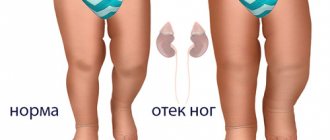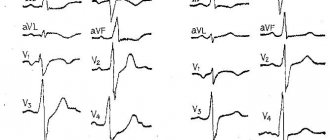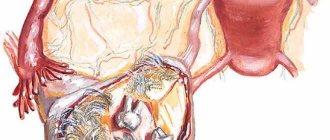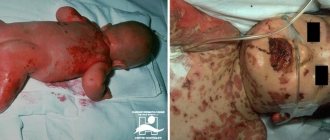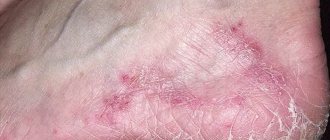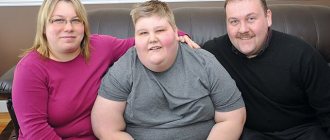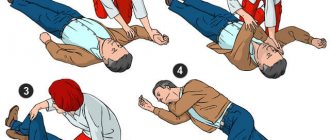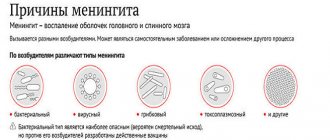Epileptic syndrome is a condition in which the convulsive state that usually occurs during epileptic seizures occurs frequently.
A seizure (the main symptom of the syndrome) usually begins suddenly, although the body warns of its occurrence with some symptoms: a day or two before the onset of a seizure, a severe or moderate headache may be observed, appetite disturbance occurs, sleep becomes restless, the person is overly irritable and complains of bad things. well-being. In some cases, the seizure begins with the appearance of an aura in the patient.
In medical practice, auras are divided into:
- motor : in this case, the patient’s seizure begins with the patient freezing in some position or starting to run somewhere;
- sensory : disturbances of the senses (visual, gustatory, olfactory);
- vegetative : discomfort in the heart, heat or cold in the head, urge to urinate, increased peristalsis;
- sensitive : paresthesia of different parts of the body is observed;
- vestibular;
- mental : an unreasonable feeling of fear, joy, euphoria.
The duration of the aura can last only a few seconds, after which the person loses consciousness, emitting a kind of cry, which is a consequence of a spasm of the vocal cords. For the next quarter of an hour, tonic convulsions occur. At this time, the patient’s breathing is delayed, the face becomes bluish-pale, the veins in the neck swell, and cyanosis increases.
For the next 3 minutes, clonic convulsions continue, during which hoarse, noisy breathing is observed. There is a variant of tongue retraction.
Cyanosis slowly recedes, saliva is released in the form of foam (it may turn red as a result of blood entering the saliva due to biting the tongue or the inside of the cheek).
During a seizure, the patient does not respond to external stimuli, dilated pupils do not respond to light, and tendon reflexes do not function. Sometimes the patient can fall asleep without leaving this state.
The entire attack lasts about 4 minutes and after it ends the person feels depressed, drowsy, and weak. The patient does not remember anything about the seizure itself.
Epileptic syndrome, unlike epilepsy, is the result of a previous disease (or accompanies it). Epilepsy is an independent disease, which most often has a congenital character. Also, the syndrome, despite the fact that the symptoms are similar to epilepsy, goes away a little easier.
Causes
One of the main causes of epilepsy is considered to be a hereditary predisposition: if parents have a history of seizure symptoms, then the child is more likely to develop them. Epilepsy also develops under the influence of the following reasons:
- Traumatic brain injury;
- Cerebrovascular accidents;
- Cerebral vascular dysplasia;
- Volumetric formations in the cerebral cortex;
- Neurosurgical intervention;
- Infectious diseases of the central nervous system;
- Previous ischemic or hemorrhagic stroke.
The occurrence of epileptic attacks is caused by the presence in the cerebral cortex of a stable focus with epileptic activity. Convulsive activity from the primary focus can spread through commissural fibers, cortical neuronal complexes, and the centrencephalic system of the brain. In the presence of increased convulsive activity over a long period of time, secondary lesions arise. They can, under the influence of certain factors, become independent and independent. As a result, the attack in the primary focus fades, but not in the secondary. This picture is observed in patients after two years of illness. Over the course of some time, tertiary foci of seizure activity may develop in the cerebral cortex.
Epilepsy can develop under the influence of the following provoking factors:
- Hormonal imbalances;
- Alcoholism and drug addiction;
- Chronic stress;
- Excessive emotional stress;
- Chronic fatigue.
Secondary attacks of epilepsy occur in patients suffering from brain tumors, cerebral vascular pathology, after hemorrhage in the head, due to poisoning with toxic substances.
It is very important to identify the disease early to reduce the likelihood of complications. Which doctor treats epilepsy? For quality therapy, it is necessary to be observed by a neurologist, epileptologist, or psychotherapist. As clinical symptoms progress, assistance from a physiotherapist or pharmacologist may be required.
Approach to therapy
Treatment of the syndrome in a child consists of finding the cause of its occurrence and eliminating it. So, if the disease is the result of a lack of potassium, it is necessary to replenish its reserves; at elevated temperatures, an antipyretic should be given.
If the cause is difficult to determine, a drug to relieve seizures is given.
Treatment of epileptic syndrome in adults is carried out by a neurologist and psychiatrist. Psychiatric help should be sought only in cases of serious abnormalities, acute psychosis, or severe dementia.
Hospitalization in such a situation is necessary, but without the patient’s permission it is unacceptable. In this situation, it is imperative to follow a diet, excluding protein from the diet.
Treatment will be much more effective if you give the body the opportunity to rest. It is also useful to exercise, reduce the consumption of liquids, spicy and salty foods. To relax the muscular system, it is necessary to take tranquilizers.
You can also use medicinal plants in the form of infusion. Violet, wild rosemary, oregano, celandine, mistletoe, hoofed grass, tansy in equal proportions are poured into half a liter of boiling water (herbs should be in the amount of 2 large spoons in total). The product is infused overnight and used for three weeks, 50 grams four times a day.
If you strictly follow the prescribed treatment with epileptic syndrome, you can lead a full life, with only a few exceptions: a person should under no circumstances drive vehicles, swim in a pond or pool unattended, or work with automated mechanisms. In all other respects, provided you take your medications in a timely manner, there are no restrictions.
Frequency of epileptic seizures
The frequency of attacks can vary from once every 2-3 months to single or multiple daily. A seizure can be triggered by sleep disturbances, stress, excessive alcohol consumption, long stays in a stuffy room, sudden flashes of light, etc. At the moment, the specific factor influencing the increase in the frequency of seizures is not yet known.
Expert opinion
Author: Daria Olegovna Gromova
Neurologist
Epilepsy has been considered one of the most dangerous and common diseases for many years. According to WHO statistics, 4-10 people per 1000 population suffer from seizures. Doctors note an annual increase in cases of onset of epilepsy. Thanks to numerous clinical studies, it has been proven that the disease is registered 2-3 times more often in countries with low and medium levels of development. This is due to the presence of a greater number of provoking factors, such as infections and a high level of injuries. According to statistics, 80% of patients with epilepsy live in such conditions.
The exact causes of seizures are still unknown. Doctors distinguish several types of seizures, as well as the factors that cause them. When selecting therapy, neurologists and epileptologists at the Yusupov Hospital take into account all the data. If you follow the rules of prevention and take anticonvulsants, about 70% of patients can live for a long time without seizures. An individual epilepsy treatment plan is developed for each patient at the Yusupov Hospital. The drugs used meet European quality and safety standards. In addition, patients are provided with personalized preventive recommendations that minimize the risk of epilepsy relapse.
What consequences?
People with epilepsy often find that their seizures frighten other people. Children may suffer from being avoided by their classmates. Also, young children with this disease will not be able to participate in sports games and competitions. Despite the correct selection of antiepileptic therapy, hyperactive behavior and learning difficulties may occur.
The person may have to be limited in some activities, such as driving a car. People who are seriously ill with epilepsy must monitor their mental state, which is inseparable from the disease.
Precursors of epileptic seizures
The first harbinger of epileptic seizures is an aura. It is individual for each patient. Thanks to the constant warning signs, patients can warn others about the onset of an attack or independently move to a safe place.
There are the following types of aura that precede the onset of an epileptic attack:
- Hallucinations;
- Sharp contraction of the muscles of the upper or lower extremities;
- Repeating the same movements;
- Burning, crawling or tingling sensation in various parts of the body;
- Sharp deterioration in mood.
The duration of the aura is several seconds. During this time, patients do not lose consciousness.
Types of seizures in epilepsy
Depending on the cause of occurrence, the following types of epileptic seizures are distinguished:
- Idiopathic – occurring in the presence of epilepsy in close relatives;
- Symptomatic – occur after a traumatic brain injury, infectious or tumor lesion of the brain substance;
- Cryptogenic – the causes of occurrence cannot be determined.
The external manifestations of a convulsive syndrome are determined by its type. If the pathological focus is localized in one hemisphere of the brain, simple or complex seizures occur.
Make an appointment
Simple partial seizures
Against the background of simple convulsions, the patient does not always lose consciousness. Clinical symptoms depend on the location of the pathological focus in the cerebral cortex. The average duration of simple partial seizures is two minutes.
Neurologists identify the following main signs of the disease:
- Emotional lability;
- Hallucinations of various types;
- Twitching in various parts of the body;
- Cardiopalmus;
- Feeling of nausea;
- Frequent feelings of deja vu;
- Difficulty understanding and reproducing words.
Complex partial seizures
The duration of complex partial seizures is one or two minutes. An aura appears before the attack begins. There is uncontrollable crying and screaming, repetition of words, and performance of certain movements. At the end of the seizure, patients are not oriented in space and time. A simple partial seizure of epilepsy can develop into a complex seizure.
Generalized seizures
Generalized seizures occur against the background of total brain damage. They are as follows:
- Tonic;
- Clonic;
- Tonic-clonic;
- Atonic;
- Myoclonic.
With tonic spasms, unconscious muscle contractions occur. Patients are bothered by severe pain in the muscles of the back, upper and lower extremities. Tonic convulsions rarely lead to fainting. The attack lasts no more than twenty seconds. Tonic seizures can occur during sleep.
Patients with epilepsy are less likely to experience clonic seizures. They manifest themselves as uncontrolled paroxysmal muscle contractions. During convulsions, foam is released from the patient's mouth. He loses consciousness. Paralysis may develop. Clonic seizures occur due to severe stress, traumatic brain injury, cerebrovascular accident, or brain tumor. During an attack, short-term muscle tension is replaced by relaxation. The attacks quickly follow each other.
The most typical and characteristic of an epileptic attack are tonic-clonic convulsions. Their duration varies from 1 to 3 minutes. If tonic-clonic seizures persist for a longer period of time, calling an ambulance is recommended. Neurologists distinguish tonic and convulsive phases in the course of an attack. In the tonic phase, the patient loses balance and consciousness, in the convulsive phase, involuntary muscle contractions occur. After the attack is over, patients do not remember what happened.
Tonic-clonic seizures may also be accompanied by the following symptoms:
- Increased salivation;
- Sweating;
- Involuntary tongue biting;
- Injury as a result of uncontrolled actions;
- Involuntary urination or defecation;
- Blueness of the skin.
Atonic seizures occur after a traumatic brain injury, stroke, infectious inflammatory processes, or in the presence of a brain tumor. During an attack, the patient loses consciousness for a while and falls. In some cases, convulsions can be expressed by twitching of the head. The attack lasts about 15 seconds. At the end of it, the patient does not remember what happened.
Myoclonic seizures are characterized by rapid jerking of various parts of the body. The attack resembles jumping inside the body. Most often, muscle contractions occur in the upper half of the body, the area of the upper and lower extremities. Myoclonic spasms can occur when falling asleep or waking up. A symptom of an attack may be hiccups. The duration of the attack is several seconds. During myoclonic seizures, patients do not lose consciousness.
Manifestations of epileptic seizures
Epilepsy is characterized by uncontrolled spontaneous seizures, the occurrence and intensity of which cannot be predicted in advance. The disease can be suspected after the first attack occurs. If the attack recurs, you should immediately consult a neurologist, since in the absence of proper treatment, the frequency of epileptic seizures only increases over time.
One of the frequent precursors of an epileptic attack is the so-called aura. It is a subjective sensation of a hallucinogenic nature that occurs in a patient with epilepsy shortly before the onset of an attack.
The aura can be manifested by the following sensations:
- certain sounds (ringing or tinnitus, melody, other sounds);
- some odors;
- visual visions;
- a feeling of deja vu;
- headaches;
- increased anxiety, etc.
Certain types of seizures, such as absence seizures, are not accompanied by an aura. During absence seizures, patients lose consciousness. The patient freezes in place and does not respond to actions or words. In this case, fainting does not happen, the person simply seems to freeze. In cases of complex absence seizures, patients experience repetitive motor acts: during an attack, the eyeballs, lips, and tongue may move.
In reflex epilepsy, the appearance of seizures is provoked by a certain irritant. An epileptic seizure in such cases can begin as a result of exposure to bright light, a flash of light, light music in a nightclub, or a fast video sequence with a frequently changing picture. In some patients, the onset of an attack is preceded by emotional overstrain and listening to certain sounds. Therefore, people suffering from reflex epilepsy need to exclude situations with provoking factors.
In addition, epilepsy may be characterized by the following symptoms:
- convulsions: during an attack, tonic or clonic convulsions appear in the muscles of the upper and lower extremities;
- disorder of consciousness: some simple epileptic seizures are accompanied by the preservation of consciousness, others by turning it off or the patient falling into a coma. In addition, during an epileptic seizure, an epileptic may see hallucinations and mentally move to another place;
- autonomic disorders: during an attack, patients experience changes in pulse, blood pressure, and vascular tone;
- memory impairment: after the end of an epileptic attack, the patient most often cannot remember what happened to him. As the disease progresses and the frequency of attacks increases, epileptics experience impaired speech and thinking, which leads to dementia.
In the early stages of the disease, as a rule, simple epileptic seizures occur, characterized by a short duration and the absence of loss of consciousness. As the disease progresses, the condition worsens and attacks become more frequent with more noticeable consequences.
Make an appointment
Nocturnal epilepsy
In one third of patients, epilepsy attacks occur at night. Pathological signs may appear when falling asleep, during sleep, or during awakening. Nocturnal epilepsy occurs under the influence of the following factors:
- Hereditary predisposition;
- Suffered traumatic brain injury;
- Excessive consumption of alcoholic beverages;
- Sleep disorders;
- Prolonged psycho-emotional stress.
The duration of a nocturnal epilepsy attack varies from a few seconds to five minutes. Most patients do not remember the seizures that occurred. Some people clearly describe the sensations they experience. An epileptic attack that occurs during a dream is accompanied by the following manifestations:
- A sharp, causeless awakening;
- Feeling of nausea, which may result in vomiting;
- Severe headache;
- Tremor;
- Pronunciation of unusual sounds;
- Speech impairment.
During a nocturnal epilepsy attack, patients may perform rash actions. They get down on all fours or pretend to ride a bicycle. You can suspect the presence of a nocturnal attack based on the following indirect attacks:
- Tongue bite:
- Traces of blood on the pillow after waking up;
- Bruises and abrasions on the body;
- Painful muscle syndrome;
- Wet bed due to loss of urinary control;
- Uncontrolled urination;
- Waking up in an unusual place (on the carpet, on the floor).
These symptoms are individual for each patient. They appear with one degree or another. Therefore, neurologists believe that nocturnal epilepsy attacks are very difficult to diagnose.
Rolandic epilepsy
Epilepsy of this type is focal and genetically determined. It manifests itself in rare attacks at night, they affect one half of the face with the tongue and pharynx. The Rolandic type is characterized by partial epileptic seizures without loss of consciousness.
The first sign of onset is tingling or numbness on one side of the face, lips, gums, or tongue. Afterwards motor paroxysms develop.
Make an appointment
Alcoholic epilepsy
This type of epilepsy develops in patients who abuse alcohol. Seizures occur due to irreversible pathological processes in the cerebral cortex. Epilepsy attacks caused by alcohol intoxication most often occur in patients suffering from the following concomitant diseases:
- Atherosclerosis;
- Consequences of traumatic brain injury;
- Brain tumors;
- Residual effects of previously suffered infectious and inflammatory diseases of the brain.
The cause of the disease may be aggravated heredity. The symptoms of alcoholic epilepsy have some peculiarities. The disease does not necessarily begin with a convulsive syndrome. Initially, the following pathological signs appear:
- Increased salivation;
- Marked weakness throughout the body;
- Paleness of the skin;
- Blueness of lips;
- Dizziness;
- Strong headache;
- Loss of consciousness;
- Nausea, vomiting;
- Uncontrolled urination;
- A spasm of the vocal cords that causes a person to emit a high-pitched scream.
An attack of alcoholic epilepsy can result in respiratory arrest and death.
Signs and symptoms of the disease
As already mentioned, the main symptoms of an epileptic seizure are:
- convulsive body movements;
- foam at mouth;
- rapid breathing;
- meaningless sounds (due to the fact that the process extends to the vocal cords);
- sudden loss of consciousness;
- manifestations of the aura.
Between seizures, the patient may be no different from normal people, although in some cases a so-called “epileptic character” is observed: a person’s behavior becomes unpredictable, the “positive” phase (kindness, weak-willedness, even flattery) alternates with the “negative” (manifestations of pettiness, anger , malice). However, most likely. “epileptic character” does not exist as such, and these manifestations are present only in those patients who suffer from complex mental disorders.
Epilepsy of newborns
Up to one year, a baby may experience the following types of epilepsy seizures: small, large and nocturnal. During a minor attack, the child throws back his head and freezes in one position. His gaze is directed to one point. The baby does not respond to stroking and sound and rolls his eyes. His body temperature may rise.
A major seizure of epilepsy is manifested by the fact that the child stretches out, bends his legs and assumes a fetal position. Convulsions, loss of consciousness and respiratory arrest occur.
During a night attack, the baby suddenly awakens and screams. His face changes. After an attack, the child cannot fall asleep for a long time. Children suffering from epilepsy may lag behind their peers in development, their memory is impaired, and mental health problems occur.
The first signs of an epileptic seizure
Often, the patient and his family are not aware of the presence of epilepsy until the first attack. It can be quite difficult to determine the reasons for its development and the specific irritant for the first time, however, the fact that an epilepsy attack is approaching can be suspected if the patient has certain signs:
- headache a few days before an epileptic seizure;
- sleep disorders;
- severe stress;
- nervousness and irritability;
- decreased appetite;
- loss of appetite.
During a convulsive attack, muscle tension and lack of response to any irritants are noted - patients do not hear sounds, do not respond to touch, pain, their pupils do not narrow or dilate. After an epileptic seizure, people become lethargic and drowsy; to restore strength and normalize their condition, they need rest and good sleep.
If convulsions last for a long time and symptoms worsen, patients need qualified medical care, for which they must immediately call an ambulance and, before their arrival, make efforts to prevent injury to the patient during convulsions. Without medical attention, status epilepticus can be fatal.
Pediatric epilepsy
Epilepsy in children is manifested by the following symptoms:
- Tonic-clonic seizures;
- Absences (minor seizures);
- Myoclonic convulsions with and without disturbance of consciousness.
This condition occurs due to the immaturity of the child’s brain, when processes of excitation, burdened heredity or organic brain damage predominate. Initially, warning signs of a seizure occur: headache, irritability, and a feeling of fear. In the generalized form of the disease, the child groans, screams and loses consciousness. All his muscles tense, his jaw clenches, breathing stops, his pupils dilate, his face becomes cyanotic.
The child's legs stretch and his arms bend at the elbows. After the completion of the tonic phase of the seizure, clonic convulsions occur. The child's breathing becomes noisy and foam comes out of the mouth. He bites his tongue. Involuntary urination and defecation occur. Minor seizures do not last long.
Absence epilepsy
This is idiopathic generalized epilepsy that occurs in preschool children. Characteristic symptoms: short-term loss of consciousness during the daytime, less often at night. This does not affect neurological status or intelligence in any way.
The attack begins suddenly, the child seems to freeze and does not react to any stimuli, his gaze is directed to the side. This condition lasts no longer than 15 seconds and is rare in isolated form. More often it is supplemented by throwing the head back, rolling the eyes, and possibly repeating some actions: stroking hands, licking lips, repeating words or sounds. The child does not remember what he did.
If severe fatigue, drowsiness are added to the symptoms, and the attack lasts for a long time, then this indicates an unfavorable course of the disease.
What does it look like in real life
Symptoms of status epilepticus are determined by severe disorders in consciousness, respiratory system and hemodynamics, which are caused by a previous attack; the number of seizures during epileptic status can range from 3 to 20 per hour.
Consciousness by the time of the next attack does not clear up and the person is in a state of stupor, numbness or coma.
With prolonged ES, the comatose state worsens, becomes deeper, convulsions take on a tonic form, an increase in blood pressure is replaced by a sharp decrease, and increased reflexion is replaced by a lack of reactions. Hemodynamic and respiratory disorders become more pronounced.
The convulsions may disappear, and then the stage of epileptic prostration begins, which is characterized by external changes:
- pupil size changes;
- the gaze becomes unconscious;
- mouth slightly open.
It is very dangerous! In this condition, death can occur.
Epistatus necessarily lasts more than half an hour. This condition should be differentiated from episodic attacks, during the intervals between which there is a complete or almost complete clearing of consciousness, as well as a partial restoration of the patient’s physiological state.
The course of convulsive SE can be divided into two phases. At the first stage, compensatory changes occur to maintain blood circulation and the metabolic process.
This condition is characterized by:
- tachycardia;
- high blood pressure;
- vomit;
- involuntary urination;
- involuntary defecation.
The second phase occurs after half an hour or an hour and is characterized by a breakdown of compensatory changes. In this state, the following processes occur:
- lowering blood pressure;
- arrhythmia;
- respiratory dysfunction;
- thrombosis of the pulmonary artery and its branches;
- acute renal and liver failure.
Non-convulsive epistatus is characterized by various disorders of consciousness:
- feeling of detachment;
- immobilization.
In the case of ES of complex partial seizures, the following is observed:
- behavioral deviations;
- confusion;
- symptoms of psychosis.
Status epilepticus from A to Z:
Other types of epilepsy
Temporal lobe epilepsy
It is characterized by the localization of the focus of epileptic activity in the temporal lobe of the brain. It manifests itself in simple and complex partial epileptic seizures. As the disease progresses, secondary generalization occurs. The patient experiences mental health disorders.
Structural focal epilepsy
The onset of the disease occurs in individuals of various age groups. The lesion is located in the temporal zone of the brain. The patient feels time speeding up or slowing down. He perceives a familiar environment as new, and a new incident as something that has been experienced for a long time.
An epileptic seizure is manifested by the following symptoms:
- Preserved consciousness;
- Turning the eyes and head towards the localization of the focus of increased activity;
- The appearance of gustatory and olfactory paroxysms;
- The presence of auditory and visual hallucinations;
- Systemic dizziness.
The patient complains of pain in the heart, stomach, nausea, heartburn, and suffocation. There is a disturbance in the rhythm of cardiac activity, an increased feeling of fear, chills, and pale skin. As temporal lobe epilepsy progresses, a secondary generalized form of the disease develops. The attack is manifested by tonic convulsions in all muscle groups, loss of consciousness.
Post-traumatic epilepsy
Develops as a result of meningitis, encephalitis, traumatic brain injury, asphyxia. The disease is more often diagnosed in children. The attack is not accompanied by loss of consciousness or occurs with impaired consciousness. If the patient loses consciousness, they may experience a secondary generalized seizure. The muscles of the foot and upper limbs are involved in the convulsive process.
Features of the condition in children
Very often, epistatus that occurs in children is a sign of the onset of epilepsy, but it happens that convulsive attacks appear already in the later stages of the course of this disease.
In newborns, a seizure occurs with partial loss of consciousness, while the reaction to external stimuli remains intact.
Generalized SE can manifest itself as tonic-clonic, clonic, myoclonic convulsions.
In nonconvulsive SE, electroencephalography is used to detect peak-wave stupor and slow waves, which reflect a state of epileptic stupefaction. Partial ES can be simple, somatomotor, or dysphasic.
In complex partial epistatus, stable preservation of epileptic twilight of consciousness is observed.
With generalized SE, the main property of an epileptic seizure is disrupted - it does not go away on its own.
The number of attacks can reach several tens or even hundreds per day. In this case, respiratory function and hemodynamics are disrupted, metabolic processes in the brain are disrupted, and the coma state can deepen until death occurs.
Why is an epileptic seizure dangerous?
During a tonic-clonic seizure, breathing stops, and in all other seizures with convulsions, additional trauma is possible due to hitting the head on a hard surface. Falls from one's own height and loss of consciousness are also dangerous. Each seizure that occurs damages the neurons of the brain, which subsequently leads to a decrease in cognitive and mental abilities, and changes in the psyche.
This does not prevent patients with epilepsy from leading an active life. However, some aspects are limited - it is prohibited to drive a car and work in production in workshops, with open fire or at height, as well as in work that requires frequent switching of attention. Properly selected therapy can increase the interictal period by months or even years.
Make an appointment
Danger of condition
Mortality in the case of status epilepticus with previously diagnosed epilepsy is 5%, in the case of symptomatic status - 30-50%. If the ES continues for more than an hour, the following serious consequences may occur:
- cerebral edema;
- oxygen starvation of the brain;
- excessive decrease in blood pressure;
- lactic acidosis - excessive accumulation of lactic acid in the body;
- electrolyte imbalance;
- mental retardation and mental retardation in children.
Non-convulsive SE is less dangerous than generalized SE, however, in this case, cognitive impairment may develop.
Diagnostics
Diagnosis of the disease occurs by taking an anamnesis. The specialist listens to complaints, on the basis of which a preliminary diagnosis can be made.
After this, the patient is sent for laboratory and hardware examinations, which makes it possible to differentiate epileptic seizures from other pathologies, allows one to find out the cause, the nature of the changes, determine the form and prescribe treatment.
The diagnosis is made by neurologists and epileptologists who determine the causes of epilepsy in adults using indications obtained from a comprehensive comprehensive examination.
Instrumental diagnostic methods
The safest hardware diagnostics is an EEG. It has no contraindications; it can be used to detect areas of paroxysmal activity. These can be sharp waves, spikes, slow waves. Modern EEG makes it possible to identify the exact localization of the pathological focus.
The most informative neuroimaging method is brain MRI. The study allows us to identify the initial cause of the deviation and determine the location of the lesion in the central nervous system.
Laboratory diagnostic methods
Epilepsy occurs under the influence of various reasons; in order to identify the presence of infection, inflammation, hormonal imbalances, genetic defects, the patient needs to take a general blood test, biochemical, molecular genetic, and check the tumor marker.
First aid for seizures
Proper care for an epileptic seizure reduces the risk of complications and injuries. The person who happens to be next to the patient should catch him and prevent him from falling. You also need to do the following:
- Place a blanket, pillow or cushion of clothing under your head;
- Free your neck and chest from constricting objects and clothing (tie, shirt, scarf);
- Carefully turn the patient's head to the side to minimize the risk of inhalation or passive reflux of vomit or own saliva;
- Open your mouth and put a cloth or handkerchief in it to prevent the patient from biting his tongue;
- Do not forcefully open your mouth;
- If breathing stops for a long time, perform artificial ventilation from the mouth to the nose or mouth.
During an attack, the patient may experience involuntary urination or bowel movements. This manifestation of epilepsy should not cause fear in others. After an attack, patients usually experience drowsiness and severe weakness.
Chapter 3.
How to help yourself or a loved one during an attack of seizures or changes in consciousness.
(Also read the separate recommendations - the chapter “ADMINISTRATION OF ANTI-CONVVANT DRUGS at home to interrupt or prevent frequently recurring seizures”)
In most cases, I am able to prevent the patient from having a recurrence of attacks. However, at the beginning of treatment, as well as in the event of a possible relapse after stopping medication, attacks may recur. In addition, according to scientists from European and American centers for the treatment of epilepsy, 20% of patients cannot completely relieve seizures (for such cases in the West there is a special term - “uncontrolled epilepsy”). Therefore, the patient himself, as well as relatives of a child or sick adult, need to know what to do during an attack. To navigate the peculiarities of the course of attacks, it is also advisable for you to familiarize yourself with the recommendations: “WHAT TYPES OF ATTACKS ARE. HOW THEY DEVELOP AND PROCEED.”
HOW TO HELP BEFORE AN ATTACK
Occasionally, before an attack, a change in a person’s behavior is noted; somewhat more often, he may only have an internal feeling of an approaching attack (aura). For each patient, these pre-attack phenomena are usually unchanged from attack to attack.
It is necessary to teach a person to pay attention to the warning signs and aura of attacks, first of all, so that he has time to find a safe place. If the attacks are accompanied by falls or convulsions, the patient should lie down before the attack begins, and if possible, on something soft.
An adult and a child, if he is old enough, should be asked about these special sensations (aura) emanating from the epi-focus just before the attack, and for one more reason. The fact is that some people manage to prevent an attack when an aura appears. The following conditions are necessary to use these methods of natural attack prevention:
1. Preserved intelligence in an adult or a fairly old age in a child
2. Presence of warning signs or aura before attacks
3. Presence of provoking factors before an attack
Natural ways to interrupt an incipient attack most often involve diverting attention from the area of the body in which the attack begins.
The easiest way to do this is by causing pain or other intense sensation in any part of the body in order to “interrupt” the sensation of the aura with a stronger stimulus: some people wear an elastic bandage on their arm (wrist) and, at the moment when they feel an attack approaching, they twist it sharply to feel the pain. The same effect is achieved when a person begins to quickly twirl a ring on his finger or an earring in his earlobe and pinch himself strongly. Another patient found that he achieved the same result by vigorously and frequently tapping his hand on some hard object. Self-stimulation by brisk walking, forceful pinching, or a sudden shift of attention while you are either in a seizure-provoking situation or just about to have a seizure are often very effective ways to prevent seizures.
For some, an excellent way to distract attention and, accordingly, suppress a seizure is, for example, loud sneezing.
In other cases, it is better to act on that part of the body or mental function that is “participating” in the attack. If a convulsive seizure begins with the same involuntary movement of a limb (say, flexion of the hand), then this seizure can be suppressed by a movement opposite to the original one (in the case of the hand, it is possible to simply straighten it). Simply trying to keep that limb still can also suppress the occurrence of an epileptic seizure. If the attack begins with tingling in the arm or other limb, then the patient may try to interrupt the attack by tightly squeezing that limb with the other hand, twisting it from side to side. If an attack begins with the sensation of an unusual odor, you can interrupt it by inhaling the even stronger smell of ammonia.
Some patients find more complex psychological distraction techniques to suppress the area of excitation in the brain - they change the pace and patterns of thinking, their motor or mental activity.
Other ways to suppress an incipient attack is to counteract the emotion that causes the attack: if you have attacks in a state of sadness or boredom, then you can choose the method of self-excitation as a counteraction. One of the patients who had complex partial seizures noticed that he was able to stop the further development of the seizure simply by loudly saying the word “No!” out loud, or by abruptly switching his attention to another object. In many patients, especially those who suffer from complex partial seizures, they occur against a background of anxiety or feelings of sadness. Measures to counteract a seizure in this case will consist of trying to avoid any thoughts that make you sad and melancholy, or a sharp and complete switch of attention.
HOW TO HELP DURING AN ATTACK
There are no real ways for others to interrupt an attack that has already begun at home - it usually ends on its own when the epi-discharge in the brain is depleted. Your personal assistance during an unexpected attack is necessary mainly to protect the patient from injury during an attack and consists of the following:
1. During an ongoing attack, do not move the patient to another place, except when he is near sharp or hot objects, electrical equipment, or on a roadway with heavy traffic.
2. In case of general convulsions, it is necessary to place the patient’s head on something soft, for example, on rolled up clothes, or put your hand under the back of the head so that it does not hit the hard floor or ground. However, in no case should you forcibly hold your head or other parts of the body motionless, trying to forcefully overcome the cramps. This will not stop the convulsions, but the patient may get injured from this.
3. To make breathing easier, loosen the patient’s tight parts of clothing: belt, belts, bra, tie, and unbutton the collar. If the patient is lying face down, turn him on his side or back so that the breathing holes are free for air to enter. For the same purpose, remove the pillow and excess linen (blanket) from the bed.
4. DO NOT give any drink to a patient during an attack or when consciousness is impaired due to the possibility of choking.
5. If the patient has visible saliva on his lips, there is a possibility that the saliva will enter the respiratory tract and the patient will cough. Therefore, if convulsions allow it, turn the patient’s head to the side, and, if possible, a little down so that saliva does not flow into the respiratory tract. During an attack, and more often after it, there may be vomiting; in a supine position, vomit can enter the respiratory tract. Therefore, it is better to turn not only the head, but also the entire body of the patient on its side. At the same time, scaffold your body with pillows or folded clothes so that the posture is stable. Make sure that the patient does not turn face down on his stomach and suffocate. If cramps prevent the patient from turning - and under no circumstances use force to counteract the cramps when trying to change position, wait until the cramps stop. Even after this, you can not rush to turn him over, but carefully monitor the patient and quickly turn him over at the first sign of the urge to vomit.
6. During an attack, it is possible to bite the tongue or cheek with teeth clenched during tonic convulsions. You may have seen the American film “Cleopatra” with the famous actress Elizabeth Taylor in the title role: Julius Caesar, who suffered from epilepsy, when an attack was approaching, bit his teeth on a special block of soft wood to prevent biting his tongue and crumbling his teeth. Do not rush to make such a block; treatment usually allows you to remove or significantly reduce these attacks.
To prevent tongue bite, some experts recommend placing the handle of a spoon wrapped in a piece of cloth (scarf) between the patient’s teeth and holding it with your hand. There is no need to do this - the patient may break his teeth on the spoon or suffocate due to the unwound fabric.
Most often, an attack develops quickly - and if a person has already clenched his teeth, there is no point in putting anything in his mouth. In addition, practice has shown that attempting the above prevention of tongue biting can cause dental injuries and other troubles. Therefore, do not put anything in the patient’s mouth. Discuss the advisability of using this method with your doctor if tongue biting recurs during repeated attacks.
HOW TO HELP AFTER AN ATTACK
Your help after the attack is over is as follows:
1. Take the person to a comfortable place or help him get there if he wants to sleep after the attack ends. When he falls asleep, you don’t need to wake him up until he wakes up. If a person does not come to his senses after an attack and immediately “falls asleep”, and the sleep is suspiciously deep and is accompanied by periodic twitching, you can “stimulate” the patient a little to make sure whether he reacts to you, or whether he has fallen into a convulsive state and to whom. If the patient does not respond, call an ambulance.
2. After the attack, when the patient has fully regained consciousness, it is recommended to give him a cup of sweet tea. However, there is no need to interrupt the patient’s sleep for this if he falls asleep after an attack. DO NOT give any drink to the patient during an attack or when consciousness is impaired.
Some non-convulsive seizures also require assistance from others, especially states of altered consciousness during which the person may make unconscious movements (psychomotor seizures). At the same time, he can get injured by bumping into something, going to the edge and falling from a height, manipulating a sharp object. During such an attack, gently change the direction of the patient’s movement away from the dangerous object, take away dangerous objects from him, talk calmly with the patient so that he is not afraid of the unusual situation when he comes to his senses.
WHAT NOT TO DO DURING AN ATTACK
Using traditional medicine methods is pointless and sometimes harmful, including covering the patient with something, burning some objects, causing any irritation, including reflexology and acupuncture (irritation of certain points on the body). Do not try to do artificial respiration or indirect cardiac massage during convulsions - this is pointless - you will not be able to breathe air into your lungs, since the cramps of the respiratory muscles will not allow you to do this. After the cessation of convulsions, breathing almost always recovers on its own.
Do not put anything in a person's mouth during an attack.
IS THERE A THREAT TO LIFE DURING AN ATTACK?
With proper treatment and following the recommendations, there is no danger to life.
Some attacks are accompanied by pronounced tonic convulsions, which consist of tensing the muscles of the body, contracting the limbs, and freezing in a certain position. Tonic convulsions can also seize the respiratory muscles, making breathing impossible. Usually the period of tonic convulsions is short-lived. If it drags on, then a sign of oxygen starvation is a bluish tint of the skin and lips. Slight blueness of the lips and nasolabial triangle often occurs during a normal attack and is therefore not dangerous.
A sign of danger is a more pronounced bluishness that spreads to the entire face and other parts of the body. Such severe attacks can occur due to inadequate treatment or status epilepticus. Status epilepticus is a condition in which an attack lasts more than 15 minutes or attacks follow one another, but the patient does not regain consciousness in the intervals between attacks.
During convulsions, despite the cessation of breathing and possible bluishness of the face, it is pointless to give the patient oxygen or perform artificial respiration. In this case, the air will still not get into the respiratory tract and lungs due to the stiffness of the respiratory muscles. Usually, immediately after the cessation of tonic tension of the body, the patient begins to breathe and the cyanosis gradually disappears (this can occur against the background of ongoing twitching and disturbances of consciousness). There is a very small possibility that breathing after a long stop in the case of severe convulsions is not restored (tonic tension decreases and the body begins to “go limp”, but there is no breathing and the cyanosis does not disappear, but on the contrary intensifies). In this case, it is necessary to immediately begin artificial respiration mouth to mouth until spontaneous breathing occurs. In all other cases, do not attempt artificial respiration. When starting artificial respiration, you must make sure that there is no vomit in the mouth and throat; if there is any, you must quickly wrap your index finger with a towel and clear the accessible airways of vomit.
Another possible danger is associated with the possibility of vomiting during an attack or immediately after it (when the patient is still unconscious) with vomit getting into the respiratory tract. Therefore, during an attack, do not panic, but wait for the moment when you can turn the person on his side so that he does not suffocate on his vomit.
If the patient is unconscious during an attack or immediately after it, it is necessary to control the position of his body and head - so that he does not suffocate, pressing his face into a pillow or any surface in a position on his stomach, or does not choke in his vomit when lying on his back. This is why tonic nocturnal attacks are most dangerous when there is no one near the person. Therefore, if a child with night attacks has the habit of sleeping on his stomach, we need to wean him off this.
In all my practice, there has not been a case of a patient dying during an attack at home or on the street - the above recommendations are a kind of additional insurance for some rare cases.
An exception to all of the above rules is an attack in the form of laryngospasm during rickets in children of the first year of life (spasmophilia). Laryngospasm is spasm and narrowing of the airway (larynx), which may or may not be accompanied by tonic spasms. With laryngospasm, unlike a normal convulsive attack, there is not one single cessation of breathing at the beginning of tonic tension of the body, but difficulty breathing, sometimes with a sound reminiscent of a rooster's crow. Respiratory cessation during laryngospasm can also occur, but it usually does not occur immediately, but after several noisy breaths. Unlike epileptic seizures, giving compressed oxygen can help with laryngospasm. You can try to interrupt a prolonged attack of laryngeal spasm by irritating the back wall of the pharynx and the root of the tongue. If breathing stops, artificial respiration is performed until the first breath is taken.
IF THE ATTACK HAPPENED IN WATER (for information on preventing accidents in water, read the relevant sections of the recommendations “LIFE STYLE DURING EPIC ATTACKS”)
1. Support the child so that his head is above the surface of the water.
2. After pulling the patient out of the water, make sure he is breathing. If not, place him with his stomach on your bent knee and clean the mucus from his mouth with your fingers. After pouring out the water, quickly place him on his back, tilt his head back so that the airways take the shape of a straight tube, and perform mouth-to-mouth artificial respiration. The chest should expand in time with your breathing.
You must know how to perform artificial respiration correctly and train for this.
3. Even if the rescued person does not complain about anything after being under water, call an ambulance or go to the hospital, as water that gets into the lungs can cause some complications.
WHEN TO CALL AN AMBULANCE
During an attack, you must be near the patient and perform the steps described above. After the end of the attack, you must call an ambulance in the following case: 1/ if the convulsive part of the attack lasted two or more minutes longer than is usually the case for your child or loved one; if the attack lasted more than 5 minutes; 2/ if the attack recurs (two or more attacks within a few hours); 3/ if the patient does not come to his senses after the attack and immediately “falls asleep”, and the sleep is suspiciously deep and is accompanied by periodic twitching, and when vigorous attempts are made to wake him up, he does not answer your simple questions (“Can you hear me”, etc.) and does not fixes his gaze on you; 4 / if after an attack the patient has a confused consciousness - he answers questions poorly and incorrectly, tries to go somewhere, has poor orientation in the time and place where he is; if after an attack the patient looks sick; 5/ if there are noticeable injuries.
In case of repeated attacks or the threat of their recurrence, the emergency doctor prescribes the administration of diazepam or sodium hydroxybutyrate. The introduction of these drugs into a vein can interrupt an attack immediately, but emergency doctors do not administer them into a vein for fear of suppression of the respiratory center by these drugs in case of increased sensitivity to them, their absence or other reasons. The same medicine, injected intramuscularly into the buttock, will begin to have an effect only after 15-20 minutes. Therefore, if attacks are not isolated, but tend to recur several times over 1-2 hours in the form of series, it is advisable to have these drugs at home and a brief extract from the medical history about the dose in which this drug was effectively administered intramuscularly or intravenously. In some In cases, it is clear to the doctor immediately or after the lack of effect from the above administration that the patient requires hospitalization.
To the table of contents of the article “Convulsions, epileptic seizures and epilepsy.”
Treatment
Neurologists at the Yusupov Hospital provide complex treatment for epilepsy. It is aimed at reducing the frequency of epileptic seizures and stopping medications during remission. According to statistics, in 70% of cases, adequately selected treatment helps to almost completely relieve paroxysmal activity in patients.
To achieve optimal results in treatment, patients are prescribed drugs for epilepsy of the following properties:
- anticonvulsants – help relax muscles, they are prescribed to both adults and children;
- tranquilizers - allow you to remove or reduce the excitability of nerve fibers; the drugs have shown a high degree of effectiveness in the fight against minor attacks;
- sedatives – help relieve nervous tension and prevent the development of severe depressive disorders;
- injections - used for twilight states and affective disorders.
Idiopathic focal epilepsy is benign. It requires symptomatic treatment. In focal forms with seizures that appear in series 2-3 times a month and are accompanied by an increase in mental disorders, neurosurgeons perform surgery.
Is epilepsy curable?
Before starting treatment, a diagnosis should be determined, because loss of consciousness and various convulsions can occur due to a sharp drop in blood sugar, anemia, poisoning, high fever, cerebrovascular accident, calcium deficiency and other conditions. Antiepileptic drugs cannot be prescribed to such patients immediately. The diagnosis of epilepsy is made only when epileptic seizures recur.
With adequate treatment, according to generalized statistics, a good therapeutic effect is achieved in 80-85 percent of patients, and in 60-70 percent of patients seizures can be eliminated completely. And this is a very good reason to stop antiepileptic drugs.
The percentage of patients with epileptic seizures could be significantly lower if patients took medications regularly and did not stop treatment on their own. The decision to discontinue medications can only be made by a doctor, and not earlier than after 5 years of treatment, if during this time the patient has not had epileptic seizures. At the Yusupov Hospital, an epileptologist always monitors how the patient’s illness develops.
What examinations are needed?
In order to diagnose the disease, the doctor examines the medical history of the patient himself, as well as his relatives. It is very difficult to make an accurate diagnosis. The doctor does a lot of work before this: checks the symptoms, the frequency of seizures, the attack is described in detail - this helps determine its development, because the person who suffered a seizure does not remember anything. Subsequently, electroencephalography is performed. The procedure does not cause pain - it is a recording of your brain activity. Techniques such as computer, positron emission and magnetic resonance imaging can also be used.
Forecast
The prognosis for epilepsy if you follow medical recommendations and take medications in a timely manner is favorable.
To do this, it is important for a person to maintain a careful attitude towards his health: maintain a daily routine, have adequate sleep, avoid overexertion, and completely give up bad habits such as cigarettes and alcohol. Loss of ability to work depends on the frequency of attacks: if they are episodic and occur at night, then there are no contraindications to performing work functions. Daytime attacks with loss of consciousness cause limited choice of work.
In most clinics, patients with epilepsy are seen by neurologists or psychotherapists, who sometimes find it difficult to understand the details of diagnosis and the intricacies of treatment of this disease. Just one EEG requires enormous experience and skills of a professional. Therefore, the Yusupov Hospital employs highly specialized epileptologists who can answer all your questions. You can make an appointment with them by calling the Yusupov Hospital.
Make an appointment
Is it possible to cure completely and forever?
Is epilepsy curable or not?
Until recently, this diagnosis sounded like a death sentence.
The patient expected progression of the disease and disability. The achievements of modern medicine make it possible to get rid of the disease completely.
Some forms of the disease that occur in childhood are considered completely curable: rolandic, benign epilepsy of newborns.
If the disease manifests itself in adulthood and the patient experiences generalized attacks, then these forms are the most difficult to treat.
In this case, doctors use antiepileptic drugs to reduce the frequency of attacks. The prognosis of the disease is also unfavorable if the epileptic has cognitive disorders.
The curability of symptomatic types of the disease depends on the degree of brain damage, the duration of the process, and the cause. In most cases, after eliminating the provoking factors, seizures disappear and no longer bother the person.
How long does it take to treat epilepsy? How to get rid of epilepsy forever? The success of treatment is influenced by the following conditions:
- Age of onset of illness.
- The nature of the attacks.
- The form of the disease.
- Degree of brain damage.
- Duration of the flow.
- Presence of concomitant pathologies.
- Presence of provoking factors.
- The correct choice of therapy methods.
